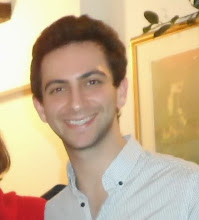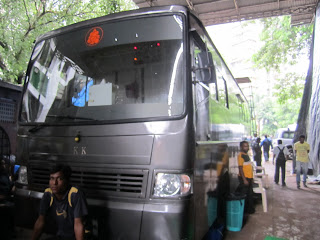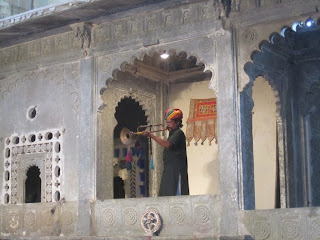Day 134:
Having explored New Delhi the day before, today it was time for a bit of Old Delhi with a visit to the massive Red Fort. Yet another example of Mughal splendour, the fort was filled with the traditional combination of moats, fountains and marble palaces. I entered the fort through the Lahore Gate which significantly now carries an Indian flag. During the fight for independence from the British this had been a nationalist aspiration! For me though the highlight was the museum section that contained newspaper extracts from the 1850s, which acted like snapshots of the British ex-pat community in Delhi all that time ago.
(health and safety?)
The fort also is famous as it once housed the Peacock throne - a mammoth solid-gold and jewel-encrusted throne built at twice the cost as the Taj Mahal. The centre-piece of the chair was the Koh-i-noor diamond which currently forms a part of the British crown jewels. It has been calculated that if the throne still existed it would be worth more than one billion dollars!!! Unfortunately it was looted from India in 1739 and broken up.
Day 135
Today was a very lazy day and my greatest achievement was buying some new shorts (my jeans just are not suitable in the heat here). In the late afternoon I caught the overnight train to Udaipur. After the horrors of my previous lower class train today I made great efforts to secure myself a bed in one of the higher AC classes. This really paid off as my cabin contained a wealthy and well-educated Indian couple who were impossibly kind and charming and a trio of French travellers (two of whom were training to be chefs in Paris!). The Indian couple had a good laugh as the four of us Westerners started choking on the impossibly spicy set-meal we were provided with on the train. The man was even nice enough to buy me some milk.
Day 136
Udaipur, Udaipur, Udaipur. What can I say? I love Udaipur. Described by Colonel James Tod as India's most romantic city, Udaipur nestles the stunning Lake Pichola and is an oasis of tranquility and beauty in a country of hustle and hassle. The whole lakeside is lined with cupola-clad palaces and town-houses. Udaipur is also of great historical importance as the home of the mighty Mewar dynasty. The current Maharajah can trace his lineage all the way back to the year 600AD and his family were renowned for their defiant opposition to the Mughal empire and their love of independence. Hell, the Mewars even built Lake Pichola itself, undertaking what was at the time the largest hydro-engineering project in the history of the world.
Oh and to continue the James Bond theme of my trip, Octopussy was filmed here! Thankfully though the strict rules of Indian modesty forbade me from whipping out my Daniel Craig swimming trunks.
(the balcony at my amazing hostel)
What could be better for me to explore on my first day than the Mewar palace? Like a fairytale castle twinned with Gormenghast, this mammoth conglomeration of balconies, towers and cupolas is probably larger than Buckingham Palace and absolutely stole my aesthetic heart. After several hours spent wandering around its rooms (alas photography not allowed) I can honestly say that I preferred this to the Taj Mahal. While the Taj Mahal is undoubtedly beautiful, it remains a monument and an empty one at that as there is barely any interior. The Mewar palace though reeked of domesticity (indeed the Maharajahs carried on living there until the late 1970s). Walking around inside I was of course impressed by the opulent state rooms, but more interesting were the private rooms which expressed an understated homely elegance that I absolutely loved. I'd imagine a tour through Queen Elizabeth's bedroom would be equally fascinating.


For quite a while I thought I could hear bagpipes and was sure I was going crazy. However, following my ear I discovered the somewhat incongruous Indian-Scottish marching band of Udaipur.
Now another reason why I love Udaipur is because it is really easy to meet people here. More importantly, it is really easy to meet fellow English travellers here. I spent most of the day with a couple from Birmingham, then had dinner with two girls from London who, like me, had just finished their LPC law course and were about to start their training contract. Small world eh?
Day 137
After a morning spent catching up with home friends on Skype (a shout out to Dani here), I strolled down to the Jagdish Temple; an Indo-Aryan temple with simply amazing carvings lining its walls.

I have to admit though that the whole day was merely one long build-up for the much-anticipated evening Indian cooking class I had booked myself. The English couple I'd met the day before had raved about this lady called Shashi's cooking school and I had been looking forward to so much that I was actually counting down the minutes on my watch. Shashi hosts the 6-hour cooking class in her house and I was joined by three English people and one girl from Switzerland. Shashi began by telling us her life story. Born a Brahmin (high caste Hindu) into a poor family, she was married off at an early age. After having two children the man died, leaving Shashi in dire poverty. As a Brahmin she was not permitted to work in many of the jobs that could have been available to a widow (Brahmins are doctors and lawyers, not toilet cleaners), so she was forced covertly to offer her services as a clothes washer (all the time wary of being discovered and shunned by her community). After many years her son made friends with two Western tourists and invited them back to his house for dinner. They were so impressed with Shashi's cooking that the tourists persuaded her to open a cooking school and learn English. Now three years later Shashi runs two classes every day of the week, is listed in both Lonely Planet and Trip Adviser (where she is Udaipur's number one tourist attraction, above even the Maharajah's palace) and is comfortably well-off!

Shashi began by outlining the various dishes we would be cooking that evening and by explaining the main spices used in Indian cooking (turmeric, anise, chilli powder, coriander seed, cardamon, pepper, oregano and cumin).
The recipes:
(1) Our first cooking lesson was on how to make Masala Chai (spiced Indian tea). A heady mixture of cardamon, pepper, ginger, basil and nutmeg was added to a pot of Assam leaves boiling in milk and strained into a glass. Most Masala Chais are overpoweringly spicy and not that pleasant, but this was absolutely delicious and moreish.
(2) Next we made various types of Pakora (fried vegetable fritters). We infused some chickpea flour with red chilli, coriander powder, anise, oregano, salt, cinnamon, bay leaves, cloves, black cardamon and black pepper then added in some ground garlic and ginger and fresh corriander leaf. Adding some water this turned into a thick batter. We then dipped anything and everything into this batter and deep-fried it in some soybean oil. My personal favourite combinations were potato and onion, paneer (cheese) and cauliflour and pea. We also learned how to make a sweet variety using bananas and sugar.
To dip our pakoras in we made both a coriander and a mango chutney. The pakoras were so warm and fragrant while the chutneys were fresh and flavoursome, so unlike the sticky, MSG crap that we buy in jars back home.

(3) Now the big one: masala (ie curry). Almost all curries follow the same basic recipe which involves frying some cumin and diced onion, then adding garlic, ginger, crushed onion and water. Onced browned, we tossed in some coriander, red chilli, turmeric, salt and more water. The room smelled so good at this point, I could not believe things could get better. But oh they did. We decided as a group that we wanted to make a (baby) aubergine and tomato curry and the sweet smell of the vegetables frying made us salivate with anticipation. What surprised me though was how different this curry tasted from the stuff we get in restaurants back home. It was much more refined and complicated in flavour as well as exhibiting many types of texture. A curry from an English restaurant is more like a bowl of grainy cement when compared with this rich, saucy beast.
Shashi also explained how we could vary the recipe to make cauliflower, potato and tomato curry (aloo gobi), pea and potato curry (aloo mater), mixed vegetable curry (sabgi/shag), potato and tomato curry (aloo tamater), chicken curry, chickpea curry (chana masala), spinach and potato curry (aloo palak), spinach and cheese curry (palak paneer), lentil curry, butter masala and finally malai kofta (my favourite). My friends back in London better prepare themselves for having to eat all of these as I practice them over the next few weeks.



(4) Next we made a vegetable palau, which is like a biryani, but with a higher proportion of vegetable to rice. We sliced some green chillis, peppers, cauliflowers, cabbages, shallots and tomatoes , frying them with some anise, chilli powder, coriander, salt, turmeric and garam marsala. We then added some chopped cashew nuts and sultanas as well as the rice. It was really helpful to have Shashi explain to us how to tell when rice is perfectly cooked. So simple a foodstuff, yet so often badly prepared! Alas too much green chilli was added and it turned out Shashi was the only one in the room that could actually eat it.


(5) Shashi then taught us how to make lassis (Indian yoghurt drinks), raita (a cooling yoghurt, garlic and cumin dip) and, most excitingly, our own paneer cheese! When I return to England I cannot wait to have another go at curdling some full fat milk with lemon juice, putting into a cheese cloth and pressing it down for 2 hours with a 5kg weight. It felt like an episode of The Good Life. We also made another type of cheese (called local cheese) which followed a similar recipe, but had added garlic and peppercorns.
(6) Now came the breads. We made a basic chapatti dough out of whole-wheat flour, salt and water, then marvelled at how this puffed out into almost a 3d sphere as we added it to a thick iron hotplate.
(the puffed up chapatti beginning to flatten after leaving the hotplate on the right)
The same dough with a bit of added oil was then used to make various types of paranthas, which we stuffed with everything from potato and anise to coconut and ghee.
The absolute highlight though was the naan making. Unlike the chapattis, the naan was made with white flour, yoghurt, sugar and baking powder. The cooking process though was similar and we spread these with an unbelievably delicious tomato paste we made from tomatoes, onions, garlic, anise, chilli powder, coriander, salt, garman masala and sugar. Surprisingly it tasted more Italian than Indian (mostly because we had only put a tiny bit of chilli in).
Finally at about 11pm we sat down to dinner in Shashi's lounge and feasted on our night's creations.
Along with the sweet paranthas, for desert we enjoyed some kala jamun (balls of condensed milk and flour, deep fried in ghee then drenched in sugar syrup). Very, very sweet! Shashi then gave us presents of bracelets and little elephant statues.







































































